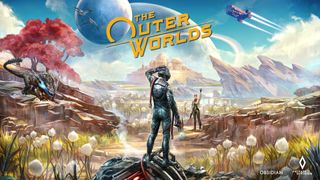
Tim Cain and Leonard Boyarsky are explaining the origins of The Outer Worlds to me over the phone, and I can't help but believe in my heart that it is all an elaborate fabrication. I'm told that production began back in 2016 in collaboration with Private Division, and that the game was finished long before Microsoft opened its cheque book to acquire the studio. That the project has been a labour of love for Obsidian Entertainment, fuelled by the passion of two reunited game directors working alongside a small team of talented young programmers and veteran RPG designers. They explain that The Outer Worlds is the most ambitious game the studio has worked on for quite some time and that it hopes its release garners enough interest to warrant a sequel. I hear what they're saying, and I'm not buying it.
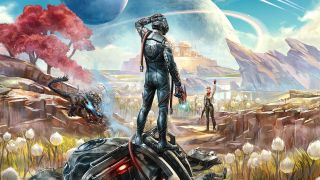
Game The Outer Worlds
Developer Obsidian Entertainment
Publisher Private Division
Platforms PC, PS4, Xbox One
Release 25 October, 2019
I can't – I'm half expecting Cain to shoot me an apologetic call any minute now, explaining that he couldn't tell me the real origin story while Private Division is listening in on the line. That The Outer Worlds isn't a new creation, but rather a surprise discovery. That Cain was rummaging through a storage cupboard one fateful afternoon and stumbled upon the source code for an Obsidian RPG that you've never played before. That he dusted off the code and set to work giving it a well-deserved polish, enough so that the studio could pass it off as a modern release. "Shhh," he'd say, "don't tell anybody."
This series of imagined events wouldn't be out of the realms of possibility for me because The Outer Worlds looks like a game torn out of time. Torn out of time, but not dated by it. Like it was regretfully put to one side sometime between 2009, as Obsidian worked through the development of Alpha Protocol and Fallout: New Vegas as freelance guns for hire, and 2012, as the studio turned to Kickstarter to fund its isometric throwback Pillars of Eternity. No studio makes RPGs in this style anymore, and there's nothing else quite like The Outer Worlds in the industry right now as a result.
The past becomes the present

"I'm a lot older than a lot of the people working on the game and when we first started on it I said to the team, 'I hope this becomes your Fallout.'" It's a sweet sentiment from Tim Cain, the co-director of The Outer Worlds, sat alongside the other co-director, Leonard Boyarsky. Once upon a time, the duo was a part of the core creative team at Interplay Entertainments – responsible for the original Fallout, one of the most influential RPGs of all time. Now, more than two decades later, they are hoping to do it all over again with The Outer Worlds.
"I hope that in 10 or 20 years people are still talking about The Outer Worlds. I hope that games are still being made in this universe. I hope other games are inspired by it..." Cain continues until Boyarsky leaps in to finish his thought; the two are easy in conversation. "I hope that it resonates with people. To do that, it needs to be satisfying in a deep way, in a way that makes people want to just keep on returning to it over and over again. I want this to feel like a universe that people continually want to play in."
To achieve this lofty goal, Obsidian has constructed a tight adventure cast out across the stars. The Outer Worlds is ostensibly about being lost in space and trying to find your place in it. You are awoken from cryostasis decades after your ship first embarked on its mission to reach the furthest edges of the galaxy, all in an effort to help settle the Halcyon colony. After being left for dead by the colonies' mysterious benefactors, it is you that will act as the unplanned variable in the decimation equation threatening to consume it all. It's heady and it's hearty – this is an Obsidian game, after all.
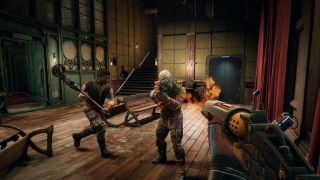
"The Outer Worlds has been playable from start to finish for about two years"
Tim Cain, co-director
The Outer Worlds is designed so that you can engage with as much or as little of this core narrative throughline as you desire. With numerous factions vying for power, with countless characters to interact and engage with across two core planets, and a medley of ships and space stations, there is plenty of scope to forge your own path through it all without it becoming disrespectful of your time or attention. "We knew from the beginning that this wasn't going to be a 100-hour epic," Boyarsky explains. "We are doing everything that we can to make sure that we can deliver a great, polished, and fun experience."
Sign up to the GamesRadar+ Newsletter
Weekly digests, tales from the communities you love, and more
In many respects, The Outer Worlds looks like a direct response to the gluttonous RPGs that have become so pervasive in the industry today. The Outer Worlds is a smaller, tighter, and more densely packed proposition than any of its immediate competition, a hand-crafted adventure that is designed to reflect your personality and preferred playstyle through its action and dialogue. "We're making the story that we're trying to tell; our story really lends itself to having smaller areas," Boyarsky continues. "This is a space science-fiction game, where you're a space hero that needs to fly around space and go to all of these different places. If we had just one big continuous map, it wouldn't really have the space opera fantasy/pulp sci-fi fantasy feel that we were going for."
It means that The Outer Worlds should feel manageable. In spite of its scope and depth, it's being created to be something that you can tackle one area, mission, or character interaction at a time. It's refreshing, really. As too is hearing the conviction the game directors' have to ensure that The Outer Worlds is as optimised and bug-free as possible. "Looking at the time and budget we had, we really wanted to take the time to make sure it was a polished experience."
"We didn't want a lot of randomised or quickly-slapped-together content, we wanted to really focus on making the content by hand and making sure it was really fun to play," Boyarsky tells me. "And the flip side of having smaller areas [and] less overall game time is that, because we put so much player-driven choice and reactivity in this game that, when you're done with it, you'll be excited to get back into it and immediately try out some different paths through it – as opposed to some of the longer games where you're like, 'Okay, I need to wait six months before I could even think about starting another playthrough of this game."
Every action has a reaction
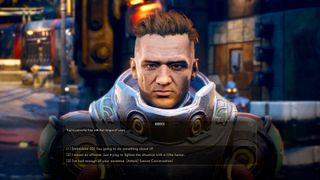
Why does Obsidian think you'll be so eager to jump back in? Well, that's because this is something of a freeform experience. The Outer Worlds is a classless RPG; you can build your character in any way that you see fit, investing in skills and perks that you think will be interesting. There is never a single path through any mission, environment, or opportunity, and you'll have plenty of scope to improvise along the way – leaning on abilities such as smooth-talking, sneaking, and fighting as a baseline of how to proceed through each and every scenario that you stumble into.
Obsidian has effectively run itself ragged to prioritise player choice and reactivity in The Outer Worlds. The goal has been to create something that always feels like it is bending to match your decision making, the natural evolution of the work the creative duo has done in this space in years gone bye. "The goal that we had on the original Fallout is the same goal that we had here," says Cain. "Players can play the game in any way that they want to, and the game will react accordingly."
"I think we've evolved since we first worked on Fallout, in terms of our understanding of how to better deliver that experience to the player," Boyarsky continues, noting one of the core lessons that the creative duo has learned since 1997. "If a game is reacting to the player, then the player needs to know and understand that it is reacting. If you don't see or feel like an outcome might have been different if you had done it in another way then it's not going to feel like your choices are making a difference."
Boyarsky goes on to explain that communicating change isn't as explicit as it might be in, say, a Telltale game – "we don't throw our hands up and say 'people are going to remember that!'" – The Outer Worlds is designed in such a way that you should immediately understand when your decisions are having an impact on both a micro and macro level. "If you can't see the fact that the game is reacting to your decisions you're just going to think 'oh, that's what happens when I play the game', and then you have to play it two or three times to see any difference. We're very cognisant of making sure that you understand why things are happening due to the choices that you make [...] we show it through action and dialogue, and the way the world reacts to your presence and the way the game plays out after that."
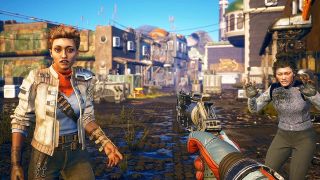
"We're very cognisant of making sure that you understand why things are happening due to the choices that you make."
Leonard Boyarsky, co-director
While it may be difficult to get your head around now, it would be very difficult for The Outer Worlds to offer the same experience to two separate players. The studio has attempted to playtest as many character builds as it possibly can, pushing through as many of its branching paths as possible, but in a world where effectively every character can live or die by your hand, has made exploring every possible outcome something of a challenge.
"We've had the game playable for so long now; we've had a chance to play all of those through multiple times, and in different manners and fashions. We've really hammered out all of the different ways that you can go through the game," Boyarsky says, with Cain jumping in to add: "The Outer Worlds has been playable from start to finish for about two years! I've played it at least 15 times."
When The Outer Worlds launches for PC, PS4, and Xbox One on October 25, you'll have the opportunity to see for yourself just how successfully Obsidian has pulled off its latest RPG experiment. Still, what reassurances can the two directors provide to convince anybody still sitting on the fence that The Outer Worlds is going to be as deep and malleable as promised? Boyarsky thinks on this for a second, chuckles to himself, and asks: "Do we really need to talk about how long we've been doing this?"
Want to know when can you start playing The Outer Worlds? Follow the link to find its launch times broken down by time zone and platform.

Josh West is the UK Managing Editor of GamesRadar+. He has over 10 years experience in online and print journalism, and holds a BA (Hons) in Journalism and Feature Writing. Prior to starting his current position, Josh has served as GR+'s Features Editor and Deputy Editor of games™ magazine, and has freelanced for numerous publications including 3D Artist, Edge magazine, iCreate, Metal Hammer, Play, Retro Gamer, and SFX. Additionally, he has appeared on the BBC and ITV to provide expert comment, written for Scholastic books, edited a book for Hachette, and worked as the Assistant Producer of the Future Games Show. In his spare time, Josh likes to play bass guitar and video games. Years ago, he was in a few movies and TV shows that you've definitely seen but will never be able to spot him in.
Most Popular


